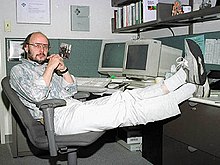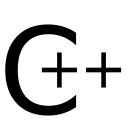History[edit]
In 1979, Bjarne Stroustrup, a Danish computer scientist, began work on "C with Classes", the predecessor to C++.[8] The motivation for creating a new language originated from Stroustrup's experience in programming for his Ph.D. thesis. Stroustrup found that Simula had features that were very helpful for large software development, but the language was too slow for practical use, while BCPL was fast but too low-level to be suitable for large software development. When Stroustrup started working in AT&T Bell Labs, he had the problem of analyzing the UNIX kernel with respect to distributed computing. Remembering his Ph.D. experience, Stroustrup set out to enhance the C language with Simula-like features.[9] C was chosen because it was general-purpose, fast, portable and widely used. As well as C and Simula's influences, other languages also influenced C++, including ALGOL 68, Ada, CLU and ML.
Initially, Stroustrup's "C with Classes" added features to the C compiler, Cpre, including classes, derived classes, strong typing, inlining and default arguments.[10]
In 1983, "C with Classes" was renamed to "C++" (
++ being the increment operator in C), adding new features that included virtual functions, function name and operator overloading, references, constants, type-safe free-store memory allocation (new/delete), improved type checking, and BCPL style single-line comments with two forward slashes (//). Furthermore, it included the development of a standalone compiler for C++, Cfront.
In 1985, the first edition of The C++ Programming Language was released, which became the definitive reference for the language, as there was not yet an official standard.[11] The first commercial implementation of C++ was released in October of the same year.[8]
In 1989, C++ 2.0 was released, followed by the updated second edition of The C++ Programming Language in 1991.[12] New features in 2.0 included multiple inheritance, abstract classes, static member functions, const member functions, and protected members. In 1990, The Annotated C++ Reference Manual was published. This work became the basis for the future standard. Later feature additions included templates, exceptions, namespaces, new casts, and a boolean type.
After the 2.0 update, C++ evolved relatively slowly until, in 2011, the C++11 standard was released, adding numerous new features, enlarging the standard library further, and providing more facilities to C++ programmers. After a minor C++14 update released in December 2014, various new additions are planned for July 2017 and 2020.[13]

